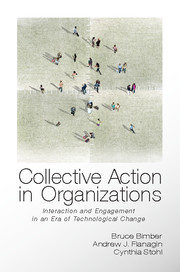Book contents
- Frontmatter
- Contents
- List of Figures and Tables
- Preface
- 1 Involvement in Organizational Collective Action in an Era of Technological Change
- 2 The Contemporary Media Environment and the Evolution of Boundaries in Organization-based Collective Action
- 3 The Collective Action Space
- 4 The American Legion, AARP, and MoveOn in Collective Action Space
- 5 Exploring Collective Action Space
- 6 Participatory Styles, the Individual, and the Contemporary Organization
- Appendix a Interaction and Engagement
- Appendix b Predicting Contribution, Identification, and Trust by Organization
- Appendix c Descriptive Statistics for the Participatory Styles
- References
- Index
4 - The American Legion, AARP, and MoveOn in Collective Action Space
Published online by Cambridge University Press: 05 June 2012
- Frontmatter
- Contents
- List of Figures and Tables
- Preface
- 1 Involvement in Organizational Collective Action in an Era of Technological Change
- 2 The Contemporary Media Environment and the Evolution of Boundaries in Organization-based Collective Action
- 3 The Collective Action Space
- 4 The American Legion, AARP, and MoveOn in Collective Action Space
- 5 Exploring Collective Action Space
- 6 Participatory Styles, the Individual, and the Contemporary Organization
- Appendix a Interaction and Engagement
- Appendix b Predicting Contribution, Identification, and Trust by Organization
- Appendix c Descriptive Statistics for the Participatory Styles
- References
- Index
Summary
In Chapter 3, we suggested that by considering organizations in a technological atmosphere in which boundary crossing is more fluid, collective action space can integrate a number of theoretical topics in social-capital theory, interest-group theory, and organization theory. We argued that this presents a potentially useful new way to look at organizations that is sensitive to variation in what memberships are like. It avoids stereotyping organizations and their members based on designations derived from structural characteristics, environmental features, or “typical” member profiles. So the question is, what about the memberships of The American Legion, AARP, and MoveOn? What do their footprints actually look like in collective action space? The first step to address these questions is to plot each member of the three organizations on the dimensions of interaction and engagement, so that we can visualize the organizations’ areas in the collective action space. Then we will look at how people participate, as well as how much they identify with their organizations and trust them, in order to understand the similarities and differences in memberships across the organizations in our study.
The Study
To analyze the memberships of the organizations, we draw on data from surveys of these memberships. To conduct the membership surveys, we worked with leaders of each organization to obtain complete membership lists and treated these lists as three populations to be sampled. We surveyed members of the organizations by using a standard computer-assisted telephone-interviewing procedure based on randomly drawn telephone numbers of members and a Web-based online survey to which we invited participants through unique e-mail invitations from randomly drawn e-mail addresses. This allowed us to obtain independent probability samples of members of each organization.
- Type
- Chapter
- Information
- Collective Action in OrganizationsInteraction and Engagement in an Era of Technological Change, pp. 106 - 139Publisher: Cambridge University PressPrint publication year: 2012



